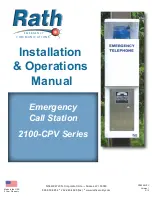
Pub. 42004-438M
300 Series Emergency Telephone Manual
Page 43 of 50
P:\Standard IOMs - Current Release\42004 Instr. Manuals\42004-438M.docx
04/19
Table 13. Programming Documentation Table
Function
Key Sequence
Default Setting User Settings
Auto-dial or Ring-Down Programming (see Table 4)
HELP Button Auto-dial Number 1
DD
*1
None
HELP Button Auto-dial Number 2
DD
*2
None
HELP Button Auto-dial Number 3
DD
*3
None
CALL Button Auto-dial Number
DD
*4
None
Primary Dial Tone Delay
#10
NN
3 seconds
Secondary Line Dial Tone Delay
#11
NN
2 seconds
Ring-down Operation
*1
None
Password Protection Feature Programming (see Table 5)
Password Protection
#14
NNNN
2468
Disconnect Options Programming (see Table 8)
Emergency Push-button Disconnect
#17
L
1 (enabled)
Call Time-out Disconnect
#12
NN
10 minutes
Dial Tone Disconnect
#19
L
0 (disabled)
ADA Programming (see Table 9)
DTMF Disconnect Option
#18
L
#181
Identification Code Entry
#13
LNNN
None
Other Programming Features
Auto-Answer Alert Feature
(see Table 6)
#16
L
0 (disabled)
Off-Hook Ringing Feature
(see Table 7)
#22
L
0 (disabled)
Extended Strobe Operation
(see Table 10)
#25
NNN
0 0 0 (disabled)
Output Four Control Setup
(see Table 11)
NN
…*8
#26
NNN
90125
#26050 (5 sec.)
Early Microphone Option
(see Table 12)
#71
L
0 (disabled)
Table Legend:
D = DTMF digit 0–9, *, or #
N = Numeric digit 0–9
L = 0—Disable, 1—Enable
Changing the Voice Annunciation Recorded Message
Change the currently stored voice message either locally or remotely following the instructions in the
applicable subsection below. The recorded voice annunciation message can also be changed by following
the initial message recording steps (see the Initial Message Recording section):









































